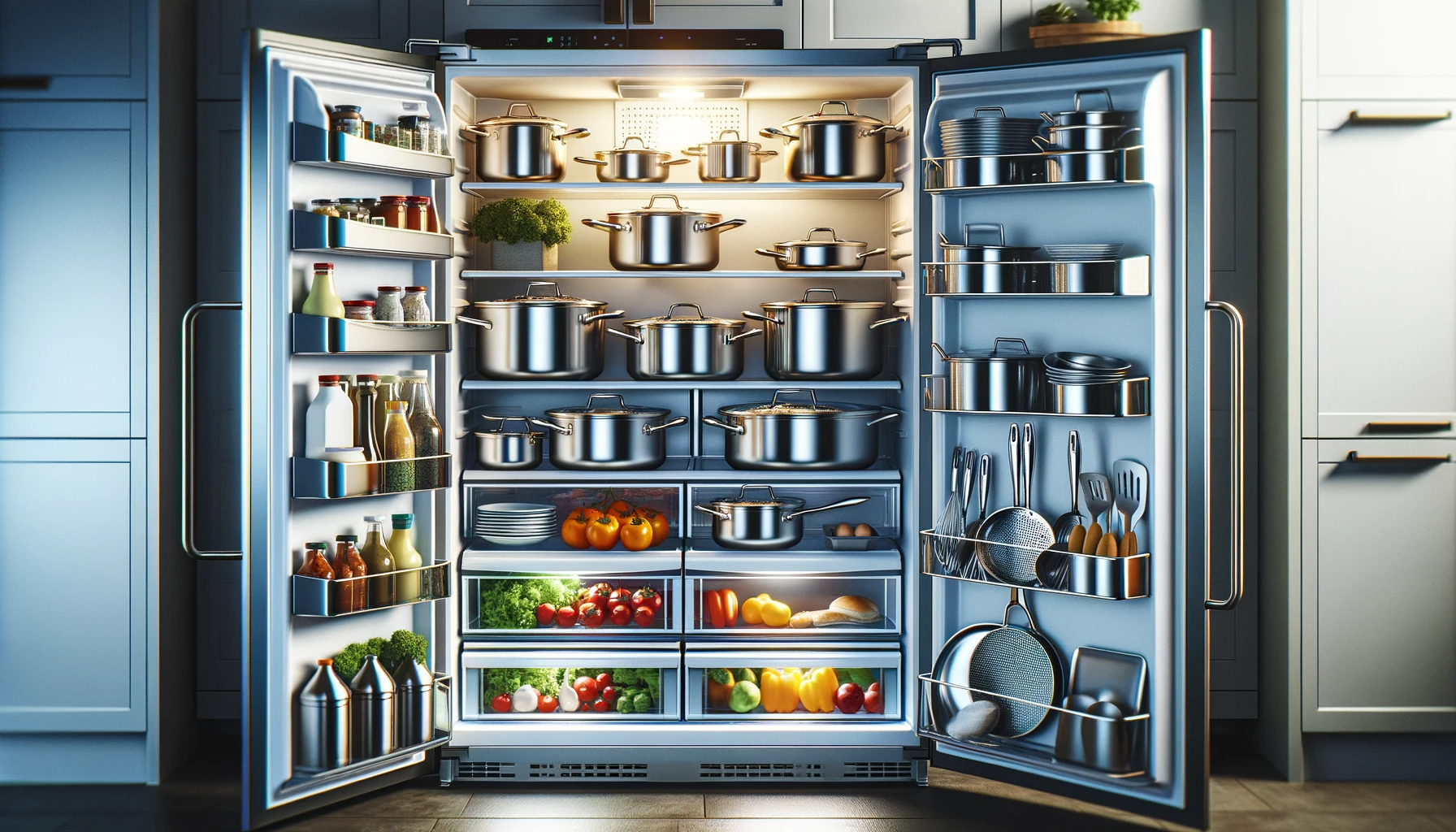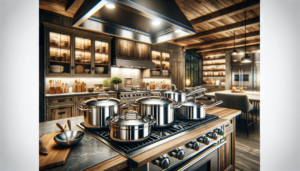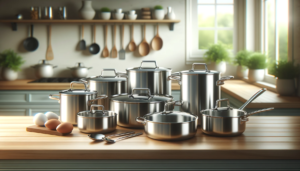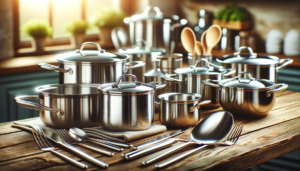Ever pulled a cold soda can from the fridge and had condensation drip all over from the temperature change? Stainless steel reacts similarly when going into the chilled fridge from hot stovetop or oven.
While most home chefs store pots, pans and baking sheets in cupboards, did you know that stainless steel cookware can actually be refrigerated as well?
Let’s examine the reasons why you’d want to refrigerate steel cookware, plus tips for avoiding temperature-related issues.
Can Stainless Steel Cookware Go in the Refrigerator?

Yes, you can place stainless steel cookware like pots, pans, and baking sheets inside the refrigerator safely with no issues.
The stainless steel material is durable enough to withstand the temperature change and humidity.
As long as basic precautions are taken when initially cooling extremely hot items, properly positioning on sturdy shelves, and towel drying thoroughly before storage, stainless steel will not corrode or damage fridge interiors.
As we’ll explore in more detail below, putting stainless steel cookware in the fridge can help quickly cool foods, set baked desserts, and maximize organization.
Why Would You Want to Put Pans in the Fridge?
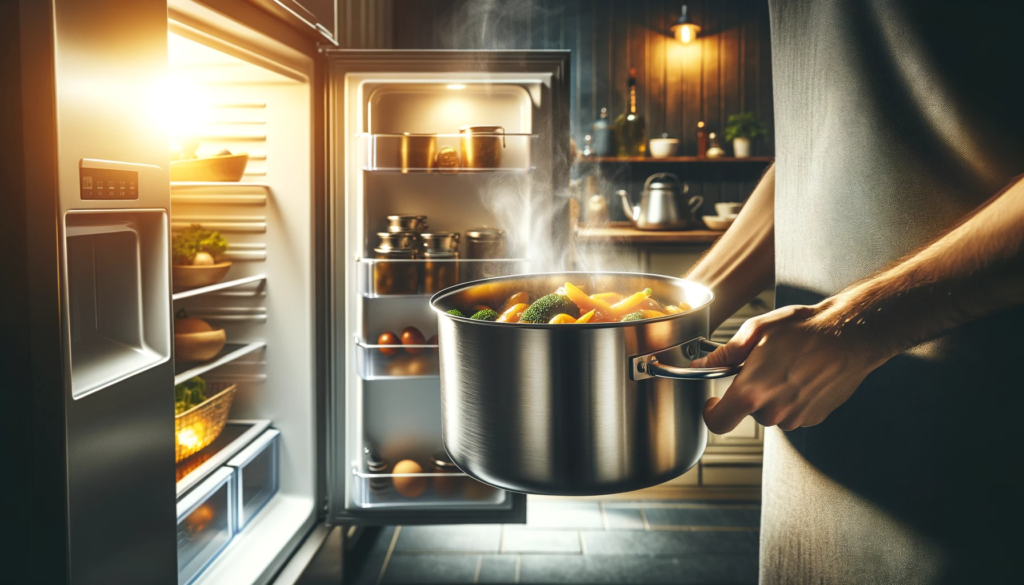
There are a few good reasons why someone may want to refrigerate a stainless steel pan:
To Rapidly Cool Foods After Cooking
Putting a hot pan into the fridge speeds up cooling so foods can reach safe refrigerator storage temperatures faster.
Many cooked foods like sauces, soups or curries need to be properly chilled prior to refrigerated storage.
Otherwise bacteria could multiply to dangerous levels.
Simply setting a simmering pot of soup or other food into an ice water bath or directly into the refrigerator effectively halts the cooking process.
Rapid cooling prevents ingredients from becoming overcooked while also minimizing the time foods spend at unsafe temperatures.
The FDA Food Code states that cooked foods must cool from 140°F to 70°F within two hours and then continue cooling to the refrigerator temperature of 40°F or below in the next four hours.
This is because perishable foods left too long in the “danger zone” between 40-140°F allows bacteria like salmonella or E.
coli to quickly multiply, making food unsafe.
So quickly chilling foods after cooking in stainless steel pans enables leftovers to safely keep longer.
Shallow containers with greater surface area cool faster, so refrigerating foods in cookware meets safety guidelines.
To Set Baked Dishes by Chilling
Placing assembled baked dishes like pie crusts or layered cakes into the refrigerator lets them properly firm up before finishing and serving.
Filling a pie shell while the crust is still warm and malleable can cause it to become misshapen or slump downwards when heavy fillings weigh down the center.
Stacking frosted cake rounds together without cooling creates messy collapsing desserts.
Throwing assembled fruit pies or multi-tier cakes into the fridge for 30-60 minutes sets the structure by chilling and firms them up nicely to hold shape, prevent slumping or runny fillings when slicing neat wedges for guests.
Dishes like cheesecake also benefit texture-wise from direct refrigerator cooling after baking.
Leaving the springform pan overnight in the fridge lets cheesecake fully set up before unmolding the next day.
Rather than dirtying up extra Tupperware or pans, accomplished bakers know the secret that refrigerating dishes directly in the stainless steel cooking pan gets superior consistency results.
For Kitchen Organization
Storing stainless steel pans inside the refrigerator is also a great way to free up space in cabinets and maximize kitchen organization.
Home cooks, especially those with tiny kitchens, often struggle to efficiently arrange bulky pots and pans within their limited cupboard space.
Tucking pots, pans and baking sheets into the fridge eliminates the need to buy extra pan racks, hanging pot racks or other specialty storage containers to corral cookware.
Just make sure to leave the pans uncovered if refrigerating long-term and allow ample airflow so no moisture accumulates and mold or mildew grows.
An advantage of stainless steel over other reactive metals is that it does not retain food odors either.
So refrigerating pans in the same fridge as food won’t make the interior smell bad over time.
For small home kitchens, utilizing air space inside the refrigerator by storing pans or cookie sheets neatly stacked provides bonus storage with no aroma downsides.
Tips for Safely Refrigerating Pans

When placing stainless steel pans into the refrigerator for cooling or storage, follow these general guidelines:
Allow Extremely Hot Pans to Cool Slightly Before Refrigerating
As mentioned previously, allow very hot pans fresh off the stove or out of a hot oven to cool slightly for 10-20 minutes before directly refrigerating, Avoid putting boiling hot pans straight into the fridge before they equilibrate towards room temperature.
While stainless steel materials themselves can handle the rapid temperature change, refrigerator interiors are not designed to withstand extremely high heat levels.
Most standard household refrigerator ranges are calibrated around 40°F and are not engineered to endure temperatures above 140°F without internal damage.
Placing a 400+ degree pan into the fridge risks cracking or weakening the glass shelves due to sudden temperature extremes.
The open flames, hot stovetop or oven have already altered the metals’ temperature significantly.
But refrigerator air is not hot enough to structurally withstand this rapid heat exchange.
Even indirect heat transfer can harm the appliance over time.
Wait patiently for pans to stop steaming or become lukewarm to the touch.
Check the external sidewalls with your hand prior to placing hot cookware directly on refrigerator surfaces or racks.
Position Pans on Lower, Sturdier Shelves
For storage duration beyond briefly cooling, relocate pans to sit directly on lower, sturdier shelves rather than higher, fragile glass shelves prone to breaking.
The bottom shelves and bins of most refrigerators tend to be coated in sturdier material or lined with slide-out solid metal trays able to bear heavier weights compared to thinner interior glass shelving.
To prevent accidentally overloading weaker shelves by the cumulative heft and density of metal cookware, keep pots and pans contained on stronger metal base trays or polymer-lined bottom level racks.
This prevents catastrophic spills if a heavily weighed down top shelf suddenly cracks or gives way under the stack of dense pans.
It also eliminates the issue of vibrations or loud noise created by metal pans intermittently touching glass shelves if they were stacked above.
For general safety and stability, store stainless steel pans on the very bottom refrigerator racks, bins or slide-out trays to prevent damage to either pans or fridge.
Ensure Pans Are Completely Dry Before Storing Inside
Take care that stainless steel pans are 100% dry following washing before placing them into refrigerated storage for any length of time.
While stainless steel itself cannot corrode or rust due to its chromium oxide coating, even very high quality pans contain microscopic traces of iron in their alloys.
If leftover droplets of water happen to linger on steel surfaces for weeks at a time without fully drying, the iron is still susceptible over a prolonged duration to eventual oxidation, which manifests as ugly spotting or reddish surface discoloration.
Small pockets of moisture clinging to crevices, handles or bases create the problems if left perpetually wet.
Just as continual moisture breeds mold growth on leftover foods or leakage stains inside the fridge walls themself over time, retention of any residual dampness between the steel and storage shelves ultimately promotes metallic deterioration too.
Therefore after hand washing pans, thoroughly dry all surfaces well with a lint-free towel before stashing in the cold fridge.
Check hard-to-reach areas like hollow pan handles or curved rims for complete water evaporation to prevent scratching of the delicate refrigerator interior or causing damage to the pans.
Taking the extra minutes to properly dry boxes, lids and bottoms keeps both refrigerated and cookware surfaces looking brand new.
Conclusion
So in summary, while most people don’t think to store cookware anywhere but cupboards, refrigerating high-quality stainless steel pans or baking sheets is perfectly safe for both food and pans with some common sense placement and drying practices.
Stashing pans inside empty refrigerator space eases kitchen clutter and creates cleaner appearance.
From an organizational standpoint, the storage flexibility streamlines workflow.
And cooling hot pans in the fridge accelerates safe food handling after cooking.
Just exercise caution with excessively hot items or fragile shelving and moisture.
By following these guidelines, refrigerating stainless steel pans offers many advantages for home chefs with limited space.
